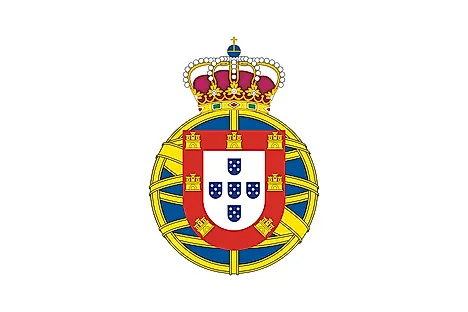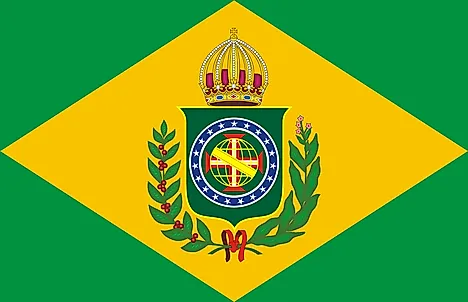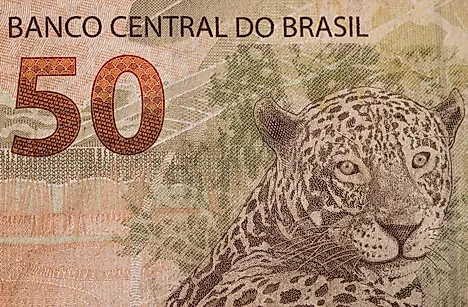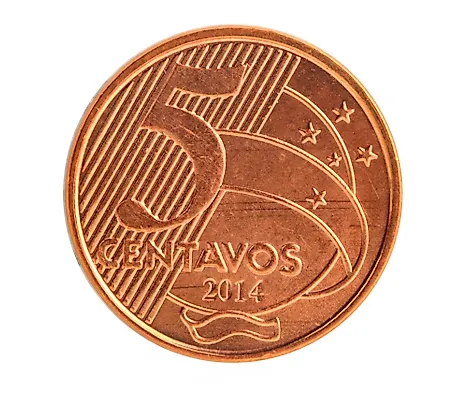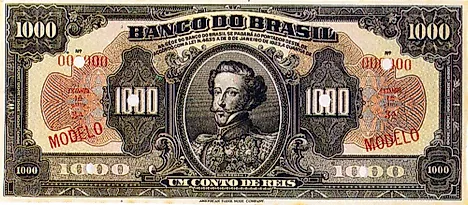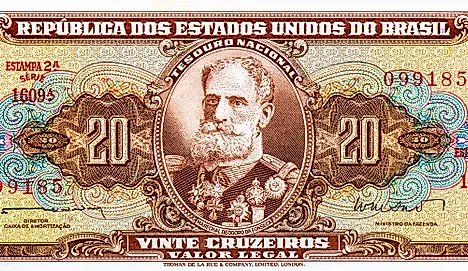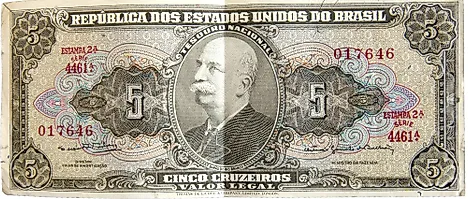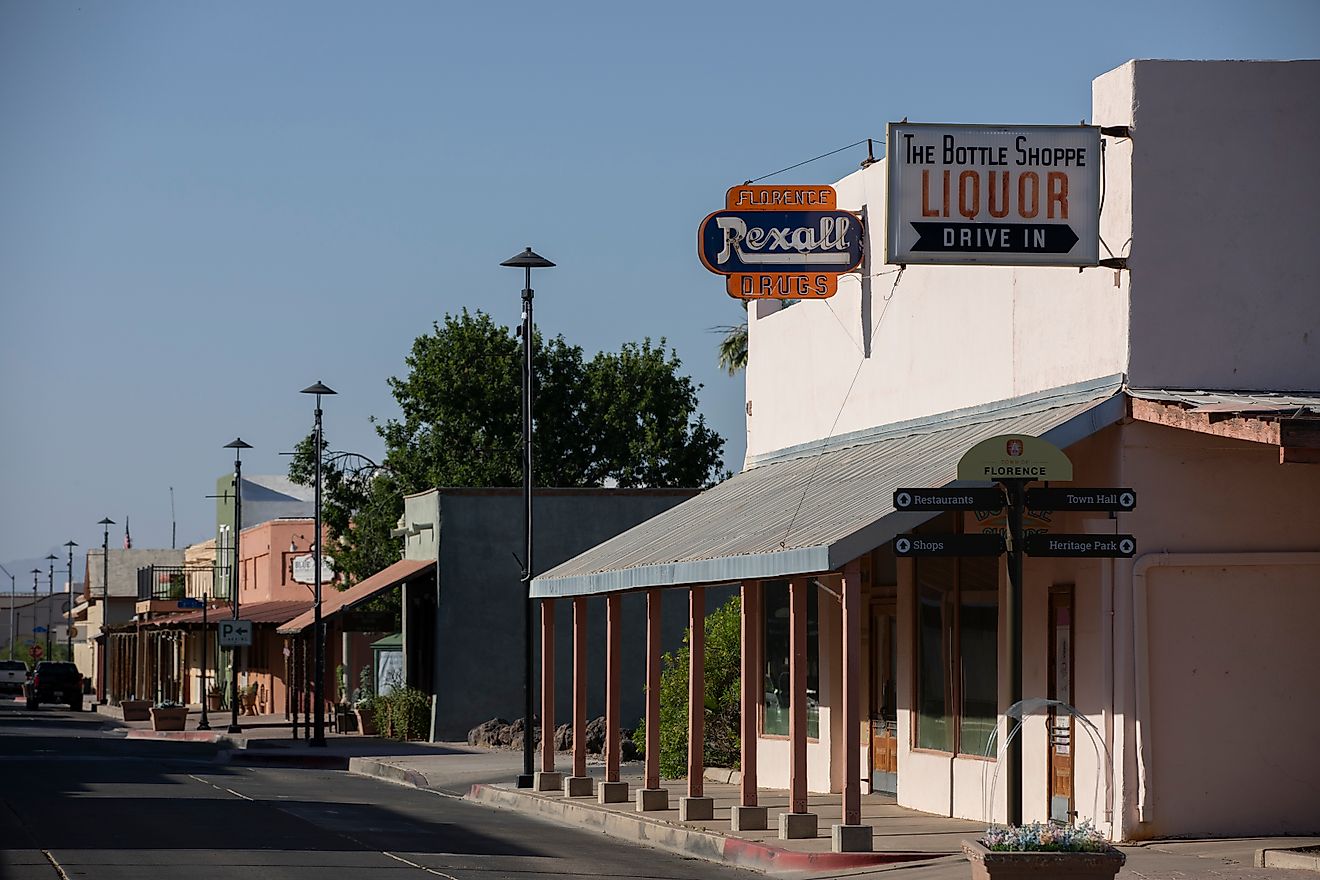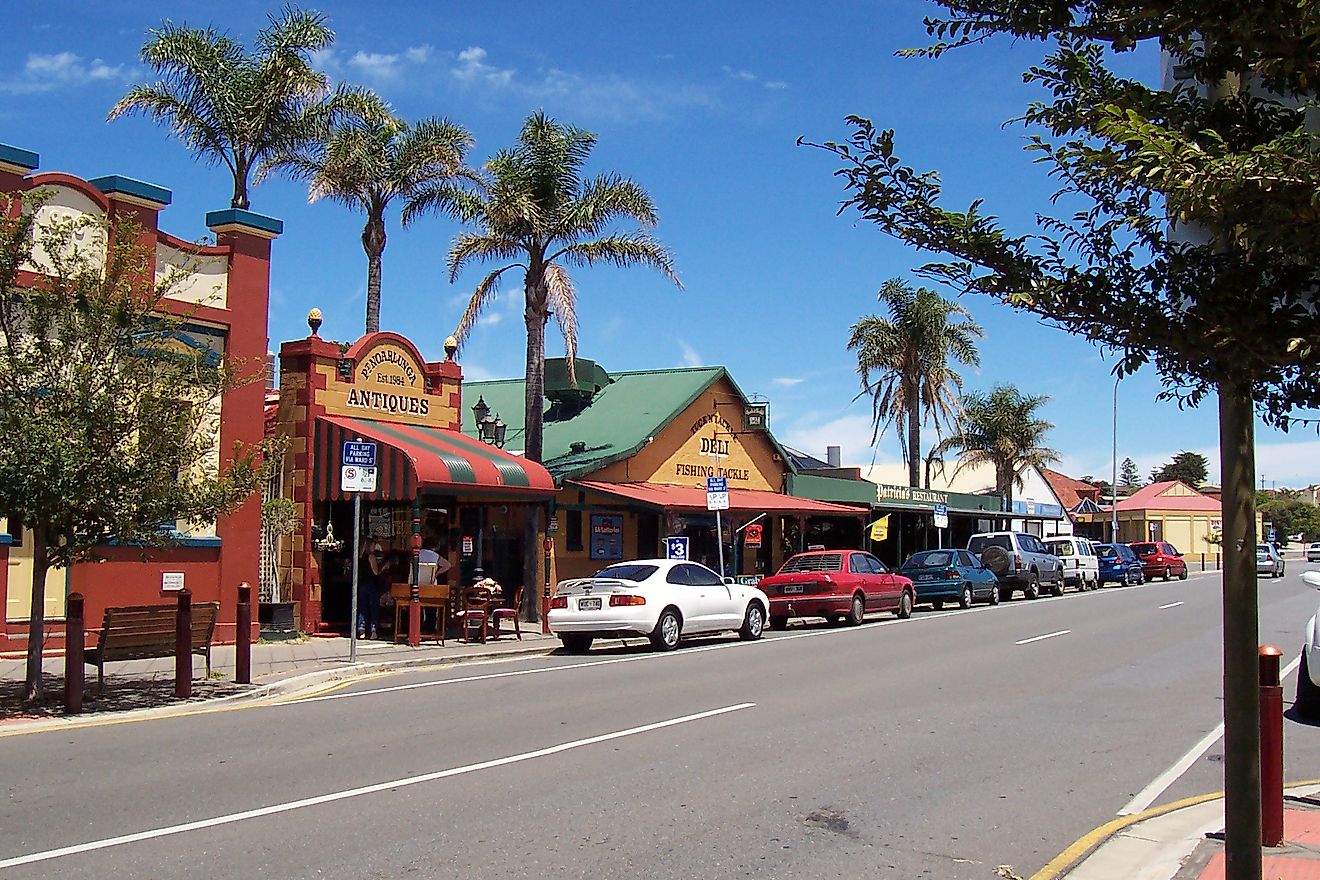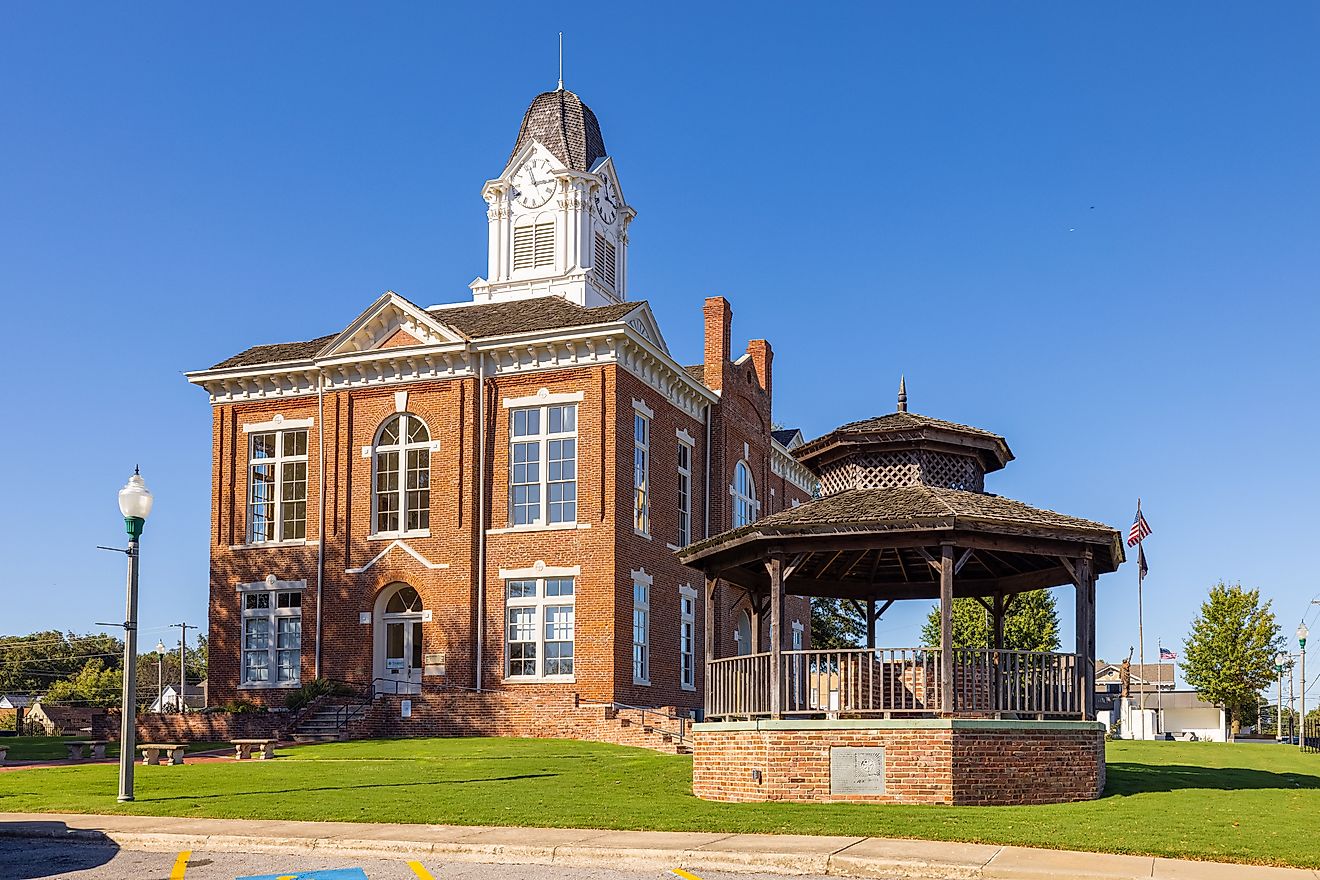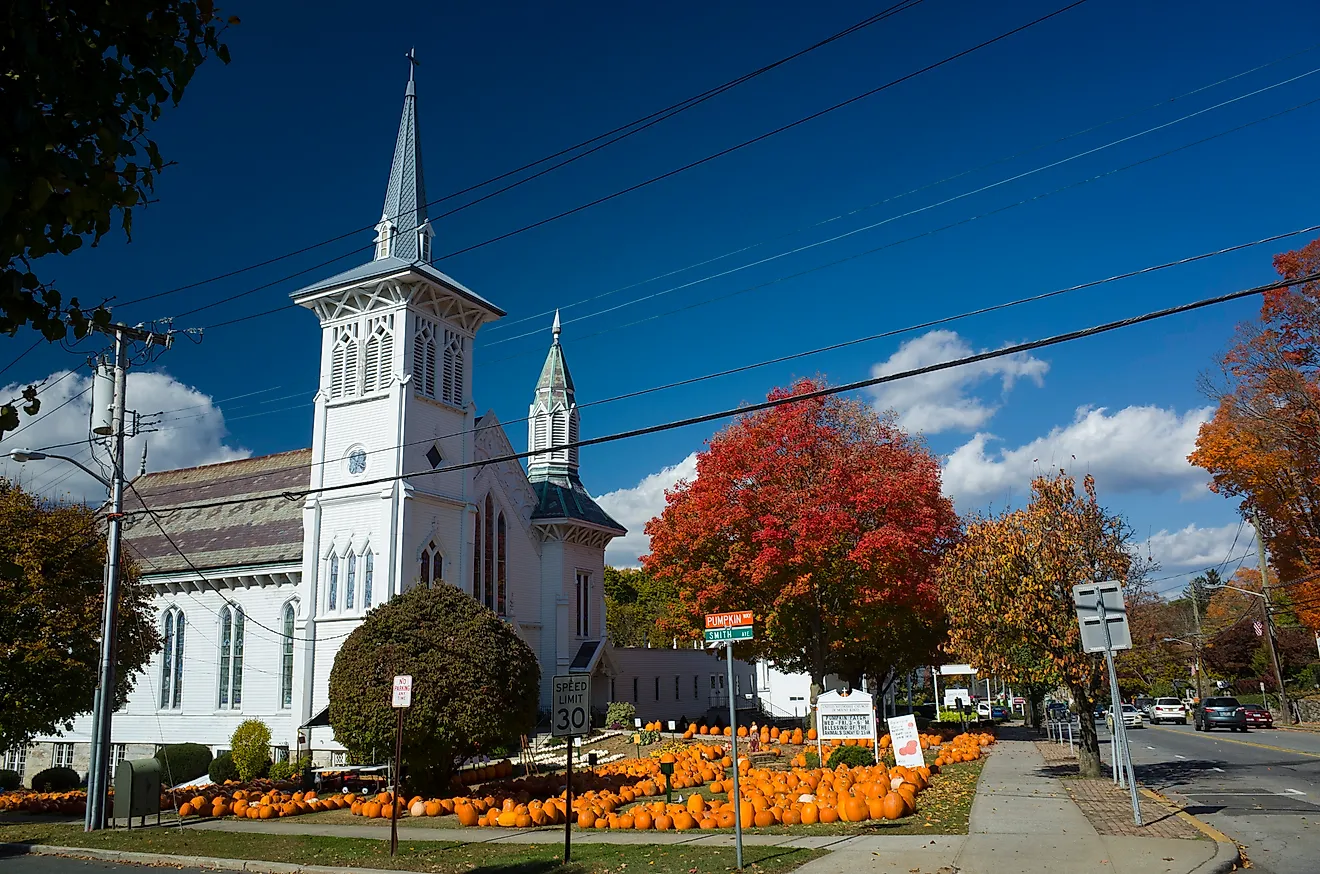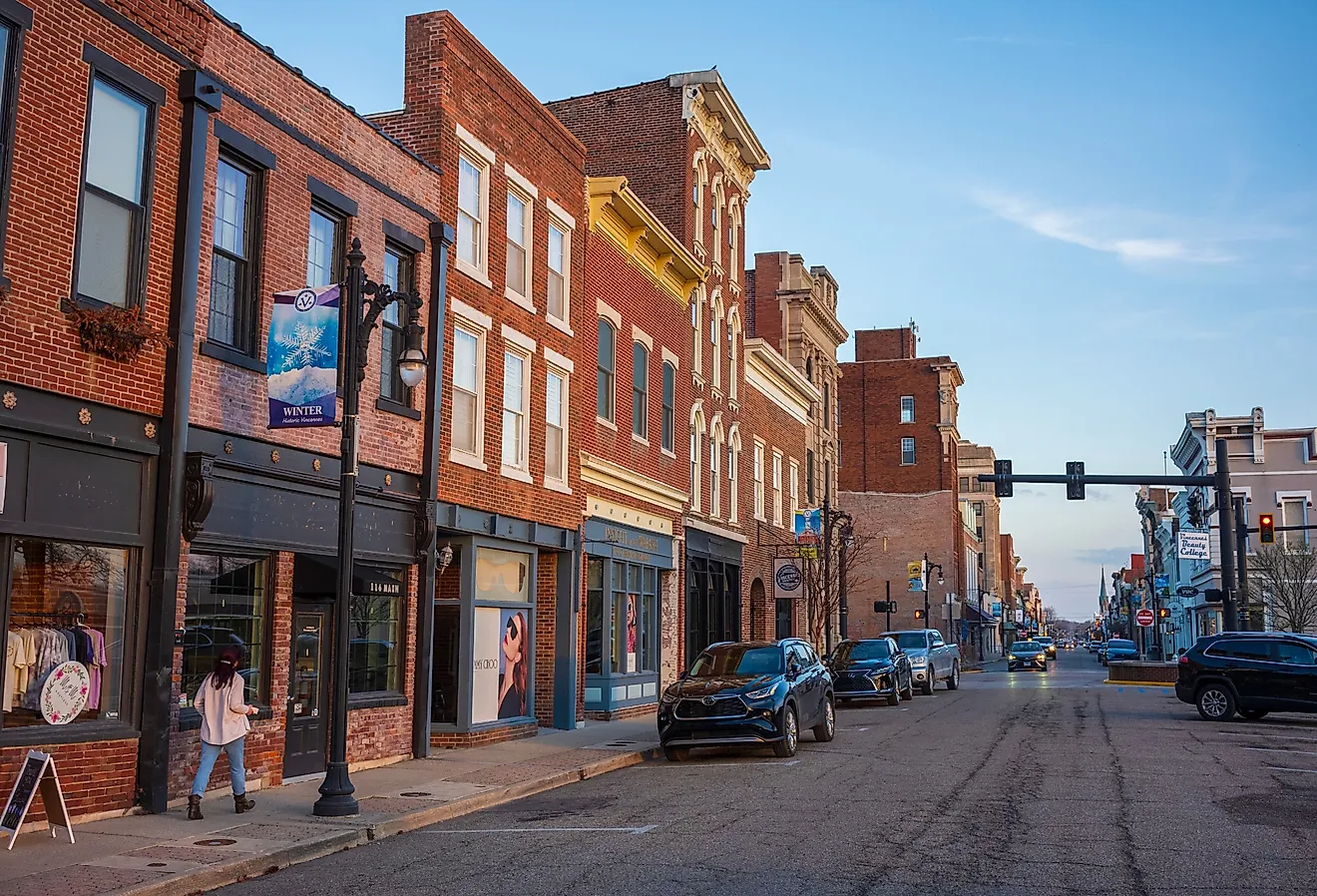Flags, Symbols & Currency of Brazil
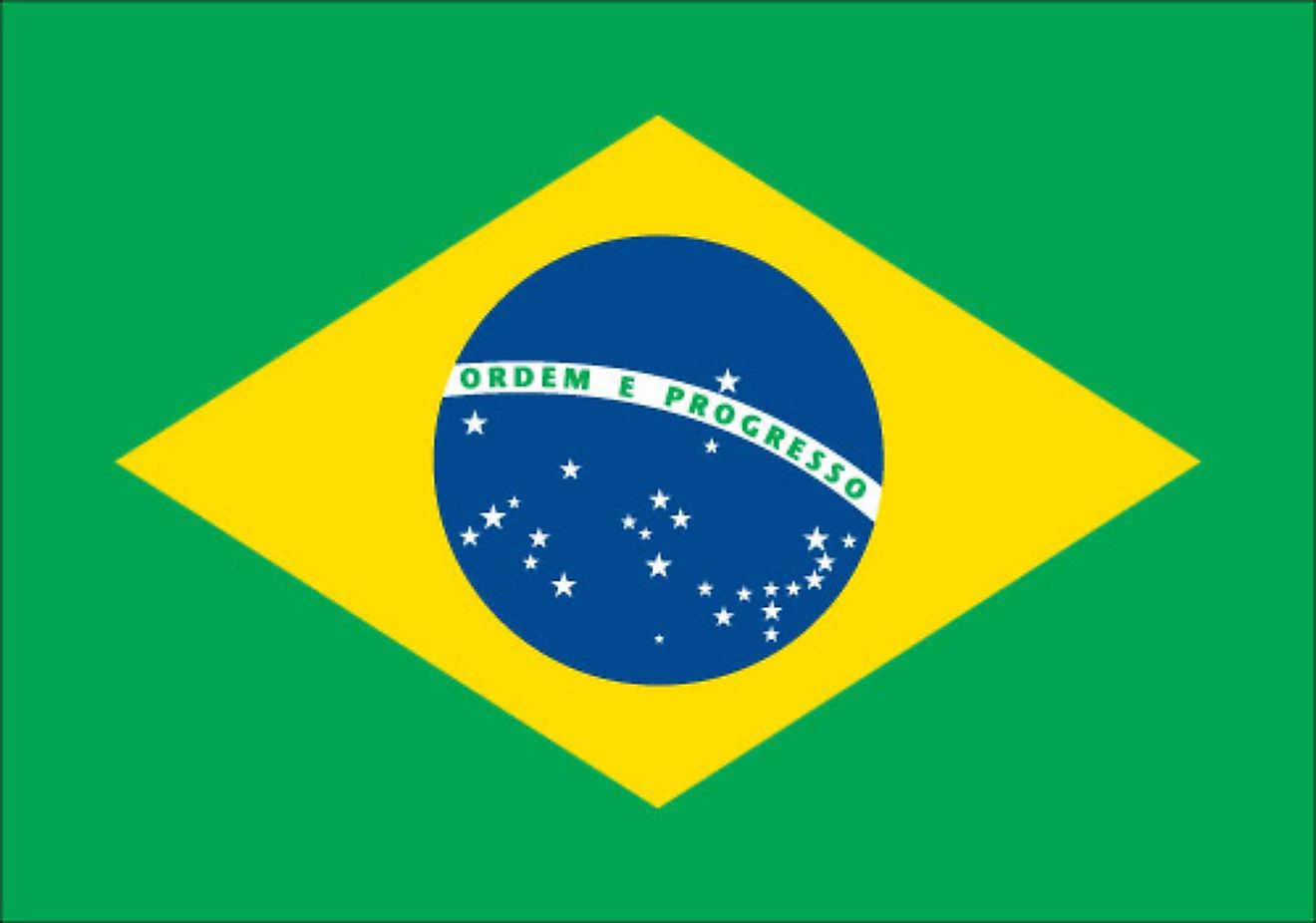
The current flag of Brazil was officially adopted on November 19, 1889. The flag design was inspired by the banner of the former Empire of Brazil (1822-1889).
The National flag of Brazil features a green field with a large yellow diamond (rhombus), and in its center floats a blue celestial globe with 27 white five-pointed stars. The globe displays a white equatorial band with the National Motto: ORDEM E PROGRESSO ("Order and Progress") in green letters. The green color of the flag represents the flora and fauna especially the Amazon rainforest, the Pantanal, as well as the jungle situated along the Atlantic Ocean. The yellow diamond (rhombus) symbolizes the wealth of the nation's soil including the rich gold reserves. The blue circle and stars, depict the sky over Rio de Janeiro on the morning of 15 November 1889 - the day the Republic of Brazil was declared. The stars on the nation’s flag are contained in the Southern Cross, which is a symbolic constellation belonging to the southern hemisphere and also a few constellations around it. The only star above the white band is Spica which represents part of the nation’s territory situated in the northern hemisphere contained in the State of Pará. The 27 white five-pointed stars symbolize the Federal District’s stability in the nation’s union. The flag has a height-width proportion ratio of 10:7.
History of the Flag of Brazil
The first Brazil flag was created during the Empire of Brazil. On September 7, 1822, a few days after the country’s independence from Portugal, the first Brazilian flag was presented to the country. From 1822-1889, the flag consisted of a green background, with a yellow diamond in the middle. When Brazil became a republic in 1889, the flag was modified, adding a blue circle on a starry sky with a curved band over it containing the national motto. The green background as well as the yellow diamond (rhombus) were both adopted from the former imperial flag. The green was the color of the House of Braganza of Pedro I, who served as Brazil's first Emperor. Gold was the color of the House of Habsburg which was the house of his wife named Empress Maria Leopoldina.
Symbols of Brazil
The National Coat of Arms of Brazil

The Brazilian coat of arms was created on November 19, 1889, and was adopted on May 11, 1992. It consists of a central emblem surrounded by coffee and tobacco branches (from left to right). Coffee and tobacco represent the two staple crops of the country. The stars in the central blue circle represent the Southern Cross. The twenty-six stars surrounding the Southern Cross represent the 26 districts of Brazil. The blue banners near the bottom of the coat of arms contain the official name of Brazil (Republica Federativa do Brasil – Federative Republic of Brazil) in its first line. In the second line, the date of the federative republic's beginning (November 15, 1889) is written.
National Motto
"Ordem e Progresso" ("Order and Progress")
National Anthem
- Anthem Title: "Hino Nacional Brasileiro" (The "Brazilian National Anthem")
- Music Composer: Francisco Manuel da Silva
- Lyricist: Joaquim Osorio Duque-Estrada
- Date of Adoption: April 13, 1831 (without lyrics) and on September 6, 1922 (with lyrics)
"Hino Nacional Brasileiro" (The "Brazilian National Anthem") is the national anthem of Brazil. It was composed by Francisco Manuel da Silva. The lyrics had been written by Joaquim Osorio Duque-Estrada. The anthem (without lyrics) was first adopted on April 13, 1831 during the Empire of Brazil and on January 20, 1890 in the Federative Republic of the United States of Brazil. The official lyrics of the Brazilian National Anthem were proclaimed by decree of President Epitacio Pessoa and adopted on September 6, 1922.
Hino Nacional Brasileiro (Portuguese)
First Stanza:
Ouviram do Ipiranga as margens plácidas
De um povo heróico o brado retumbante,
E o sol da liberdade, em raios fúlgidos,
Brilhou no céu da pátria nesse instante.
Se o penhor dessa igualdade
Conseguimos conquistar com braço forte,
Em teu seio, ó liberdade,
Desafia o nosso peito a própria morte!
Ó Pátria amada,
Idolatrada,
Salve! Salve!
Brasil, um sonho intenso, um raio vívido
De amor e de esperança à terra desce,
Se em teu formoso céu, risonho e límpido,
A imagem do Cruzeiro resplandece.
Gigante pela própria natureza,
És belo, és forte, impávido colosso,
E o teu futuro espelha essa grandeza.
Terra adorada,
Entre outras mil,
És tu, Brasil,
Ó Pátria amada!
Dos filhos deste solo és mãe gentil,
Pátria amada,
Brasil!
Second Stanza:
Deitado eternamente em berço esplêndido,
Ao som do mar e à luz do céu profundo,
Fulguras, ó Brasil, florão da América,
Iluminado ao sol do Novo Mundo!
Do que a terra, mais garrida,
Teus risonhos, lindos campos têm mais flores;
"Nossos bosques têm mais vida",
"Nossa vida" no teu seio "mais amores."
Ó Pátria amada,
Idolatrada,
Salve! Salve!
Brasil, de amor eterno seja símbolo
O lábaro que ostentas estrelado,
E diga o verde-louro dessa flâmula
– "Paz no futuro e glória no passado."
Mas, se ergues da justiça a clava forte,
Verás que um filho teu não foge à luta,
Nem teme, quem te adora, a própria morte.
Terra adorada,
Entre outras mil,
És tu, Brasil,
Ó Pátria amada!
Dos filhos deste solo és mãe gentil,
Pátria amada,
Brasil!
Brazilian National Anthem
First Stanza:
The placid shores of the Ipiranga river heard
the resounding shout of a heroic folk,
And the sun of Freedom in shining beams,
shone in the homeland's sky at that instant.
If the pledge of this equality
we managed to conquer with strong arm.
In thy bosom, O Freedom,
our chest defies death itself!
O beloved,
idolized homeland,
Hail, hail!
Brazil, an intense dream, a vivid beam
of love and hope descends to earth,
If in thy beautiful, smiling and limpid sky,
the image of the (Southern) Cross blazes.
Giant by thine own nature,
Thou art beautiful, strong, a fearless colossus,
And thy future mirrors that greatness.
Adored Land,
Amongst thousand others,
art thou, Brazil,
O beloved homeland!
Of the sons of this ground,
Thou art kind mother,
Beloved homeland, Brazil!
Second Stanza:
Eternally lying on splendid cradle,
to the sound of sea and under deep sky light,
Thou flashest, Brazil, crocket of America,
illuminated by the sun of New World!
Than the more garish land,
thy smiling, pretty prairies have more flowers,
"Our groves have more life",
"Our life" in thy bosom "more loves".
O beloved,
idolized homeland,
hail, hail!
Brazil, of eternal love be a symbol
the starred labarum which thou displayst,
And say the laurel-green of this pennant.
"Peace in the future and glory in the past"
But if thou raisest the strong mace of justice,
thou wilt see that a son of thine flees not from battle,
nor do those who love thee fear their own death.
Adored Land,
Amongst thousand others,
art thou, Brazil,
O beloved homeland!
Of the sons of this ground,
thou art kind mother,
Beloved homeland, Brazil
The Currency of Brazil is the The Brazilian real
The official currency of Brazil is The Brazilian Real (R$). It is made up of subunits known as centavos where 1 Brazilian Real is made up of 100 centavos. The Brazilian Real is printed locally by the Casa da Moeda do Brasil and is issued by the Central Bank of Brazil. The Brazilian Real was introduced into circulation in 1994 to stabilize the economy which had experienced high inflation and replaced the cruzeiro real which was subsequently demonetized.
Coins and Banknotes
During the introduction of the New Brazilian Real in 1994, the Central Bank of Brazil issued stainless steel coins in 50, 25, 10, 5, one centavo, and one real denomination. However, the one real and one centavo coins were soon withdrawn from circulation by the Central Bank. The current banknotes in the circulation of the Brazilian Real are issued in 100, 50, 20, 10, 5, and two real denominations. The Central Bank has also issued commemorative coins and banknotes in line with the celebration of historical events. New polymer banknotes were issued by the Central Bank of Brazil in 2004.
Historical Currencies of Brazil
The Brazilian real (Old)
The old Brazilian Real (Rs$) was the first official currency to be used in Brazil and was introduced by the Portuguese during the country’s colonial period, replacing the Portuguese real. One Brazilian Real was comprised of 1000 subunits known as Reis. It was still used after Brazil gained independence in 1822. The old Brazilian Real was replaced by the Brazilian cruzeiro in 1942.
The Brazilian cruzeiro
The Brazilian cruzeiro was the official currency used in the country in the 20th century. The cruzeiro was named after the Southern Cross constellation whose Brazilian name is “Cruzeiro do Sul.” The currency was issued three times in the country’s history with the first issue being in 1942, replacing the colonial Brazilian Real. The cruzeiro was reissued in 1967 due to increased inflation and was in circulation until 1986. The Brazilian cruzeiro (Cr$) was issued a third time in 1990. The third cruzeiro was replaced in 1993 by the cruzeiro real.
The Brazilian cruzeiro real
The Brazilian cruzeiro real was introduced by the Central Bank of Brazil on August 1st, 1993, as a replacement for the Brazilian cruzeiro. The Brazilian cruzeiro real was made up of 100 units known as centavos which only existed for accounting. However, the currency’s circulation in the economy was short-lived with the cruzeiro real being replaced by the current Brazilian Real on June 30th, 1994 with one Brazilian real being equivalent to 2750 cruzeiros reals.
